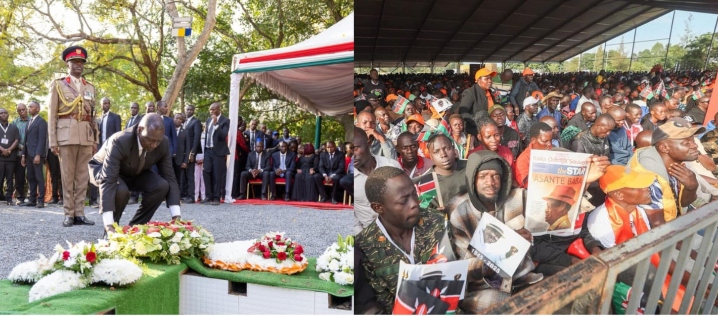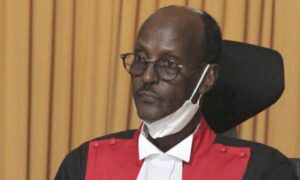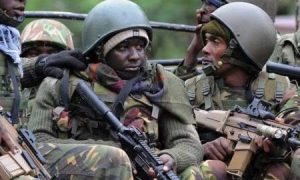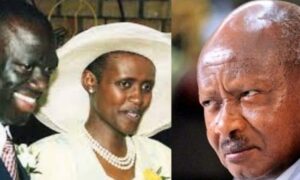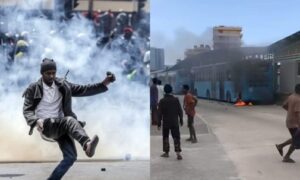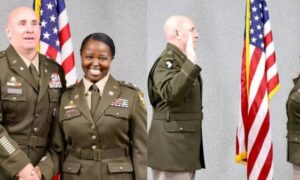In the soft light of Sunday afternoon, thousands gathered on the rolling grasses of Bondo, Siaya County, to bid farewell to one of the most enduring figures in the country’s political life – Baba Raila Odinga.
Known affectionately as Baba (“Father”), Raila’s final journey was as much a reflection of the man as it was a mirror of Kenya’s evolving democracy: animated, fractured, hopeful, and poignantly unresolved.
The ceremony began with an Anglican service at the Jaramogi Oginga Odinga University of Science and Technology (JOOUST), minutes from his ancestral home.
The Kenyan flag draped his coffin, a swift lance of colour against the midnight blue of mourners’ suits and the white headscarves of women in attendance.
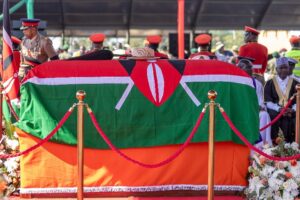
Alongside military guards and the national band, the 17-gun salute echoed the deep respect accorded to him – and the ambiguity of the stage of his role in Kenya’s history.
A full 21-gun salute is reserved for a sitting head of state; 17, the number used here, is the protocol for a former prime minister.
“Now finally Baba is home,” declared Raila Odinga Jr, his eldest son, his voice carrying across the green fields.
Just days earlier, the atmosphere in Nairobi had been tense, even deadly. The crowds that had converged at the Kasarani Stadium saw at least five people die and hundreds injured as police fired warning shots and used tear gas.
That stark reminder of Kenya’s fragility – even while mourning one of its most unifying figures – set the frame for Sunday’s turnout: thousands of mourners and dozens of African leaders and regional dignitaries gathered for a final act of tribute.
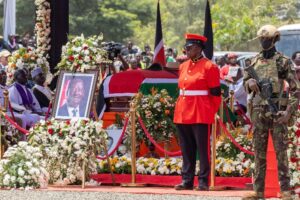
A man shaped by struggle
Born in 1945, Odinga was the son of Kenya’s first vice-president, Oginga Odinga. Over decades, Raila became synonymous with opposition politics – he ran for president five times, survived allegations of electoral injustice, and was once imprisoned for treason under a one-party state.
He served as prime minister from 2008 to 2013 and was deeply involved in writing Kenya’s progressive 2010 constitution.
Yet his legacy is paradoxical. He never captured the presidency he so often sought, and yet, as President William Ruto reminded the mourners, “One of his own students” sits now in the seat of power.
Many regarded Raila as a champion of democracy, but others perceived in him the tensions of identity politics, regional loyalty, and unfulfilled promise.
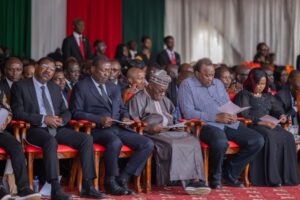
Scene at the burial
At the burial site beside his father, at Kang’o ka Jaramogi in Bondo, the mood blended solemnity with celebration. A military band played as mourners wept openly.
The casket was lowered slowly into the earth; Odinga’s trademark hat and walking stick were placed atop it – symbols of the man, the journey, and the struggle.
Then came the gun salute; brass and reverence wove through the air. The graveside hush was interrupted only by faint sobs, the rustle of thousands of white handkerchiefs and the distant call of a vuvuzela, launched by one mourner in homage.
President Ruto stood nearby, sombre. He evoked Baba Raila as a unifier: “He helped steady the country when it shook,” he said.
Bright banners with Raila’s face fluttered in the breeze; his portrait dominated the venue, as if in silent testimony to his legacy.
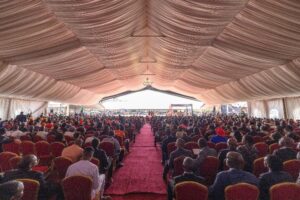
A nation at crossroads
As the services concluded and the dust settled, Kenya found itself at something of a pivot. Raila’s passing leaves a vacuum in the leadership of the Orange Democratic Movement (ODM) and in the broader opposition coalition.
Already, cracks are appearing: some party figures align with the government pact Odinga helped broker with Ruto; others vow independence.
This fragmentation matters. Kenya heads into 2027 with major elections looming. Raila’s ability to galvanise large sections of the electorate insulated his faction from internal disorder.
Without him, the landscape shifts.
READ ALSO: Raila Odinga Jokes About Death and Having ‘Fun’ in Hell
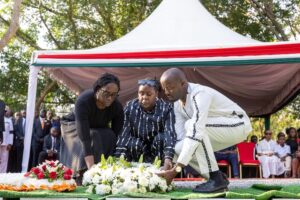
Looking forward
In Bondo, as dusk settled and the last mourners departed, one thing was clear: the politics of memory would now start.
According to supporters, Baba Raila remains the embodiment of struggle, sacrifice, and hope. For critics, he is a reminder of the perils of this nation’s unfinished business.
His burial may have concluded the ritual of mourning, but his death invites questions: Who picks up the mantle? What will become of the pact he forged with the government?
Will Kenya avoid slipping back into the divisions that marked his earlier campaigns?
PAY ATTENTION: Reach us at info@gotta.news.

